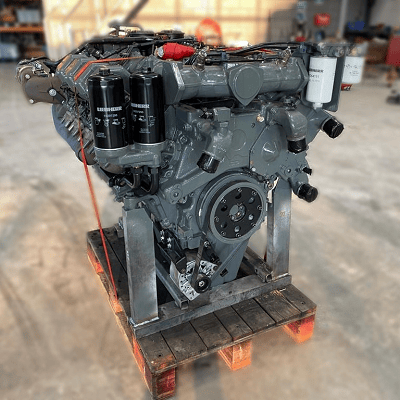The process of a dyno test on a Liebherr engine

When it comes to heavy machinery, reliability and power are paramount. Liebherr, a name synonymous with innovation and excellence in engineering, stands tall as a pioneer in the realm of heavy equipment and machinery. From towering cranes to robust excavators, Liebherr’s engineering prowess extends to the heart of these machines. We delve into the world of dyno testing a Liebherr engine, uncovering the meticulous process behind unleashing the raw power concealed within.
The foundation of excellence
Before we embark on the journey of dyno testing, it’s crucial to understand the foundation upon which Liebherr engines are built. With decades of engineering expertise and commitment to quality, Liebherr engines are crafted to withstand the most demanding environment and deliver unparalleled performance. Each component is meticulously designed and rigorously tested to ensure reliability, efficiency and longevity.
The process
1 Preparation: The engine undergoes meticulous preparation before being mounted onto the dynamo meter. This includes ensuring all connections are secure, fluids are filled to the appropriate levels, and sensors are properly calibrated.
2 Mounting: The engine is carefully mounted onto the dynamometer, a specialized device designed to simulate real-world operating conditions. Precision is paramount during this step to ensure accurate results.
3 Initial checks: Once mounted, a series of initial checks are conducted to verify proper alignment, connection integrity, and functionality of all engine systems.
4 Warm-up: The engine is started and allowed to warm up to operating temperature. This ensures consistent results and minimizes the risk of damage during testing.
5 Baseline testing: With the engine warmed up , baseline tests are conducted to establish initial performance metrics. This includes measuring power output, torque, fuel consumption, and emissions at various RPM levels.
6 Load testing: The engine is subjected to progressively increasing loads to simulate different operating conditions, such as idle, partial load and full load. This allows engineers to assess performance across the entire operating range and identify any potential issues or optimization.
7 Data analysis: Throughout the testing process, data is continuously collected and analyzed in real-time. Advanced instrumentation and software are used to monitor performance metrics and identify trends or anomalies.
8 Optimazation: Based on the data analysis, adjustments may be made to optimize engine performance. This could involve fine-tuning fuel injection timing, adjusting air-fuel ratios, or optimize turbocharger boost pressure.
9 Validation: Once testing is complete, the results are meticulously reviewed and validated against predetermined criteria and specifications. Any deviations or anomalies are thoroughly investigated to ensure accuracy and reliability.
10 Reporting: Finally, a comprehensive report is generated detailing the results of the dyno testing, including performance metrics, observations, and any recommendations for further optimization or refinement.
The outcome of dyno testing
Dyno testing a Liebherr engine is more than just a routine procedure – it’s a testament to the unwavering commitment to excellence that defines Liebherr’s engineering philosophy. By subjecting their engines to rigorous testing and analysis, Liebherr ensures that each engine delivers the uncompromising performance, reliability, and efficiency that customers expect.
In conclusion, dyno testing a Liebherr engine is not just about measuring power output. It’s about unlocking the true potential of these remarkable engines and ensuring they exceed expectations in the most challenging environments imaginable.
An anchor assembly that enables anchor points for weight lift and for height entry or fall protection. The assembly of the present disclosure generally includes: a stud, an external elongated surface with load-bearing threads, and a through tunnel fabricated on the stud , the through-tunnel intersects and is perpendicular to the longitudinal axis of the stud; member comprising an eyelet surrounding the opening and a pair of retainers extending from the eyelet, each retainer defining a hole at its central axis , and defines a hole having a diameter 0.1 to 2 mm larger than the diameter of the stud; the retainers are spaced apart from each other for receiving the stud through the hole, and are axially aligned with a cavity of predetermined length; a nut with sidewalls , the sidewall defines an internally threaded passage through which the nut is fixable to the stud and located within the cavity for insertion between the pair of retainer members, the nut on the side The wall has a pair of axially aligned and radially extending through holes; the through holes are adjustably aligned with the passage tunnel to form a continuous passage thereof; and a pivot pin that can be filled through the through holes and Passage through the tunnel to lock the nut onto the stud. The eyelet of the assembly of the present disclosure is configured to be rotatable about the longitudinal axis of the stud, and the locked nut prevents movement of the member along the longitudinal axis of the stud.
Rotary Furnace Anchor,Clip Anchor,Metal Screw Anchors,330 Stainless Steel Refractory Anchor
Puyu kiln technology (jiangsu) CO.,LTD , https://www.anchorpy.com
![<?echo $_SERVER['SERVER_NAME'];?>](/template/twentyseventeen/skin/images/header.jpg)